Land use, fire, and climate contributed to deforestation on the Pacific Islands
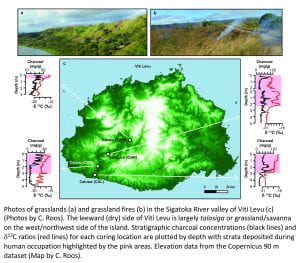
Three thousand years ago, human colonists encountered islands in remote parts of the western Pacific (Remote Oceania) for the first time. The deforestation and ecosystem degradation that followed is often attributed to human land use and exploitation. This interpretation has become a modern environmental parable about the inevitable negative ecological impacts of human activity. However, as awareness of the role of climate in shaping ecosystem vulnerability has increased, we wondered if Pacific Island deforestation could be associated with the influence of both climate and land use. Archaeological findings indicate that the first settlers in Remote Oceania were farmers who brought with them domesticated plants and animals as well as slash-and-burn farming techniques1; therefore, land use and fire were primary mechanisms capable of driving deforestation. However, the role of climate and fire–grassland feedbacks in driving deforestation in the region is poorly understood.
To investigate the influence of El Niño droughts on fire activity and deforestation before and after settlement, we used a landscape geoarchaeology approach to reconstruct the fire and grassland history on the leeward (dry) side of Viti Levu, Fiji, the fourth largest island in Remote Oceania (See above). Terrestrial soil cores were obtained from small watersheds that are tributary to the Sigatoka River. We used sedimentary charcoal and stable isotopes of soil carbon from these samples to reconstruct fire and grassland abundance across roughly 600 km2 over the past 7,000 years andcompared these records with El Niño frequencies recorded in lake sediments at Laguna Pallcacocha, southern Ecuador.
We found evidence of small fires and minor representation of grasslands before human settlement occurred roughly 3,000 years before present (yr BP). Following human settlement, charcoal and isotopic signatures of grasses increased dramatically, which appears to confirm the idea that human land use drove the deforestation of Pacific islands. However, comparing these fire and grass histories to regional charcoal records as well as proxies for El Niño drought frequencies indicates that fire and grass dynamics were shared across the region, corresponding to increasing periods of drought. These findings suggest that the climate could also be a plausible cause of deforestation by driving fire and grassland expansion. Given the human history of Remote Oceania, it is likely that climate variation enhanced the vulnerability of Oceanic forests to fire and conversion to grasslands or, that human activity enhanced the climate vulnerability of these ecosystems.
Our work highlights the complex relationships by which human land use, fire, and climate interact. In some cases, human activities (such as active fire management) can reduce the influence of climate on fire activity. In other cases, human activities such as deliberate or accidental burning can amplify the impacts of climate. This historical case provides long-term evidence to support the notion that wildfire management can have an important effect on fire–climate relationships.
You can find the original article here:
Roos, Christopher I., Julie S. Field, and John V. Dudgeon
2023 Fire Activity and Deforestation in Remote Oceanian Islands Caused by Anthropogenic and Climate Interactions. Nature Ecology & Evolution 7:2028-2036. [PDF] [LINK]
Culture and anthropogenic fire regimes
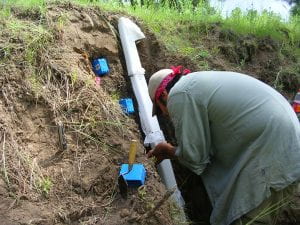
Co-author and White Mountain Apache tribal member, Nick Laluk working on a stratigraphic profile in the Forestdale Valley on the White Mountain Apache reservation.
Paleofire scientists often focus on human population size or density to the exclusion of other human variables in the study of human influences on past fire regimes. Here, with colleagues from University of California, Berkeley, White Mountain Apache Tribe, and the University of Arizona, we show that human-influenced fire regimes varied with different cultures of the residents of the eastern Mogollon Rim region of central Arizona. For centuries during Ancestral Pueblo and Apache land use, anthropogenic burning increased burned areas primarily to support agriculture. For centuries under Western Apache land-use, fires were frequent enough to substantially change fuel loads to support hunting, foraging, and pasturage for domesticated livestock.
You can read more in the open access paper in Quaternary Research below.
Roos, Christopher I., Nicholas C. Laluk, William T. Reitze, and Owen K. Davis
2023 Stratigraphic Evidence for Culturally Variable Indigenous Fire Regimes in Ponderosa Pine Forests of the Mogollon Rim Area, East-Central Arizona. Quaternary Research 113:69-86. [PDF] [LINK]
Indigenous burning buffered climate impacts

Fire-scarred ponderosa pine (Source: Wikimedia Commons)
The ecological importance of Indigenous burning and fuel management has been much debated, particularly in dry forests of western North America where lightning fire frequencies are high. Using an extraordinary collection of nearly 5000 fire-scarred trees across dry forests and three in Arizona and New Mexico, my colleagues and I were able to assess the impacts of Indigenous fire management by Diné (Navajo), Hemish (Jemez), and Ndée (Apache) people on fire-climate relationships. We show that Indigenous fire management weakened the impact of climate on fire activity at local (stands of a few acres) and landscape scales (100s sq mi).
Fragmentation of fuels by anthropogenic pyrodiversity (a mosaic of many small burn patches) may have weakened the influence of climate on fuel production and drying for fire spread even if the particular cultural and economic purposes of burning that created the pyrodiversity varied across the three different cultural groups. This shows that #goodfire can reduce the impact of climate on fire activity – it did so for centuries in the SW, particularly under Indigenous management.
This study would not have been possible without collaborations with Diné, Hemish, and Ndée communities and scholars. My co-authors and I acknowledge that tribal elders describe deep connections to traditional territories since time immemorial for Diné, Hemish, and Ndée people. Although archaeology and history document varying intensities and locations of land use and settlement, we recognize that Diné, Hemish, and Ndée connections to their traditional territories extend deep in the past and are ongoing.
The original study:
Roos, Christopher I., Christopher H. Guiterman, Ellis Q. Margolis, Thomas W. Swetnam, Nicholas C. Laluk, Kerry F. Thompson, Chris Toya, Calvin A. Farris, Peter Z. Fulé, Jose M. Iniguez, J. Mark Kaib, Christopher D. O’Connor, and Lionel Whitehair
2022 Indigenous fire management and cross-scale fire-climate relationships in the Southwest United States from 1500 to 1900 CE. Science Advances 8:eabq3221. [PDF] [LINK]
Press coverage can be found here:
In Science magazine: https://www.science.org/content/article/indigenous-americans-broke-cycle-destructive-wildfires-here-s-how-they-did-it
In Popular Science magazine: https://www.popsci.com/environment/indigenous-burn-practices-southwest-wildfire/.
In Axios magazine: https://www.axios.com/2022/12/07/wildfires-indigenous-cultural-burning
In Courthouse News Service: https://www.courthousenews.com/native-americans-managed-wildfire-risk-with-controlled-burns-for-hundreds-of-years/
Reimagine fire science for the Anthropocene
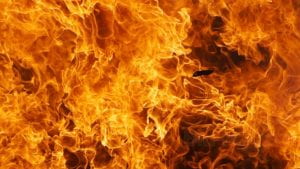
In May 2021, a group of more than 80 fire scientists across disciplines met in a virtual workshop organized by the National Science Foundation's Division of Environmental Biology and Know Innovation. Together, we began to imagine what is necessary for fire science to meet the challenges of the Anthropocene - the new era of human dominance in the Earth System. We identified five major challenges for scientists and funding agencies to address that are encapsulated in this figure.
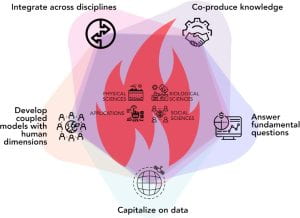
I was part of the lead authorship team for the synthesis paper published in the open access journal PNAS Nexus. You can read a press release about the paper here.
Shuman, Jacquelyn K, Jennifer K Balch, Rebecca T Barnes, Philip E Higuera, Christopher I Roos, Dylan W Schwilk, E Natasha Stavros, Tirtha Banerjee, Megan M Bela, Jacob Bendix, Sandro Bertolino, Solomon Bililign, Kevin D Bladon, Paulo Brando, Robert E Breidenthal, Brian Buma, Donna Calhoun, Leila M V Carvalho, Megan E Cattau, Kaelin M Cawley, Sudeep Chandra, Melissa L Chipman, Jeanette Cobian-Iñiguez, Erin Conlisk, Jonathan D Coop, Alison Cullen, Kimberley T Davis, Archana Dayalu, Fernando De Sales, Megan Dolman, Lisa M Ellsworth, Scott Franklin, Christopher H Guiterman, Matthew Hamilton, Erin J Hanan, Winslow D Hansen, Stijn Hantson, Brian J Harvey, Andrés Holz, Tao Huang, Matthew D Hurteau, Nayani T Ilangakoon, Megan Jennings, Charles Jones, Anna Klimaszewski-Patterson, Leda N Kobziar, John Kominoski, Branko Kosovic, Meg A Krawchuk, Paul Laris, Jackson Leonard, S Marcela Loria-Salazar, Melissa Lucash, Hussam Mahmoud, Ellis Margolis, Toby Maxwell, Jessica L McCarty, David B McWethy, Rachel S Meyer, Jessica R Miesel, W Keith Moser, R Chelsea Nagy, Dev Niyogi, Hannah M Palmer, Adam Pellegrini, Benjamin Poulter, Kevin Robertson, Adrian V Rocha, Mojtaba Sadegh, Fernanda Santos, Facundo Scordo, Joseph O Sexton, A Surjalal Sharma, Alistair M S Smith, Amber J Soja, Christopher Still, Tyson Swetnam, Alexandra D Syphard, Morgan W Tingley, Ali Tohidi, Anna T Trugman, Merritt Turetsky, J Morgan Varner, Yuhang Wang, Thea Whitman, Stephanie Yelenik, and Xuan Zhang
2022 Reimagine fire science for the anthropocene. PNAS Nexus 1(3):pgac115. [PDF] [LINK].
Indigenous burning is not easily replaced or imitated
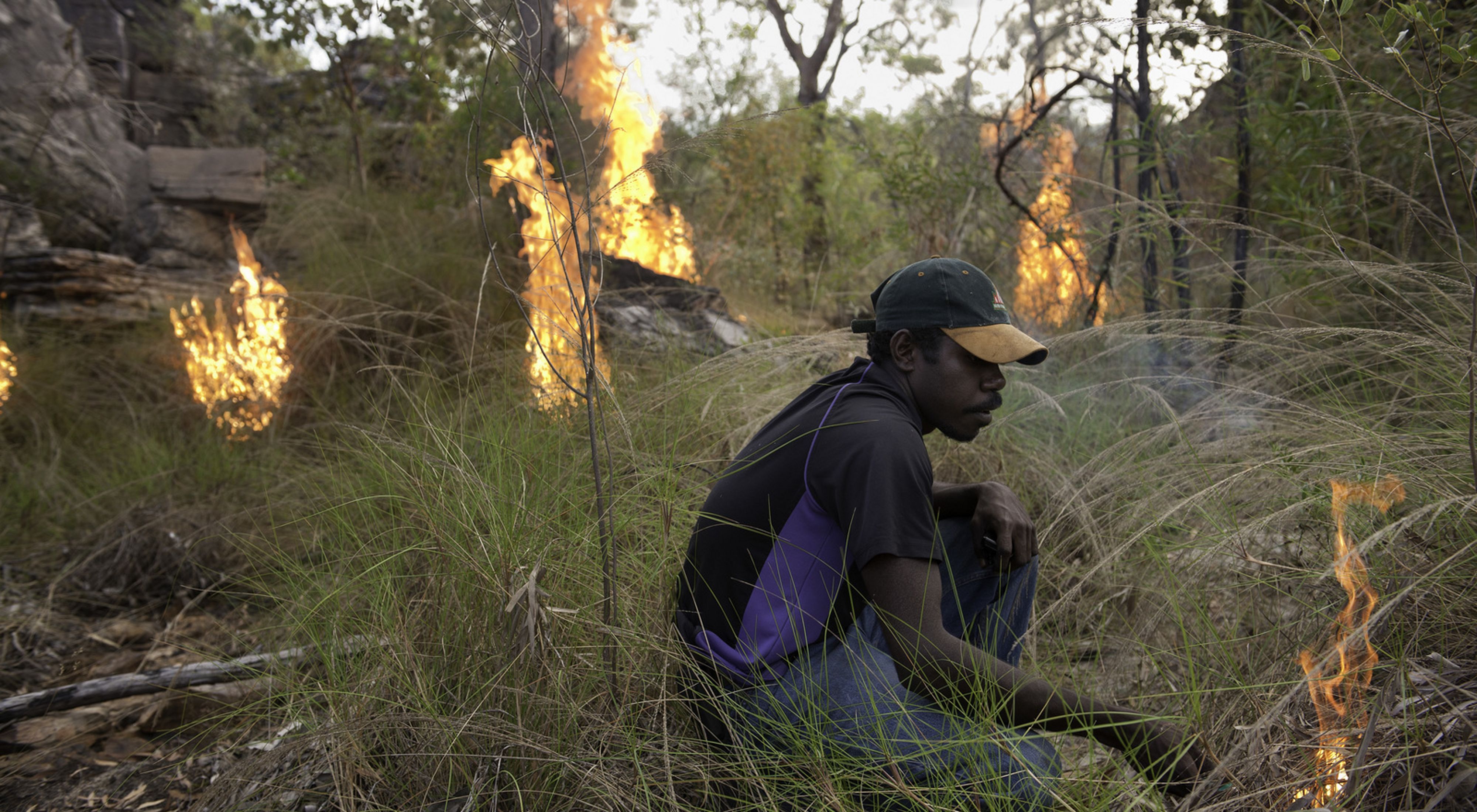
Photo from the Nature Conservancy Australia.
Cultural fire knowledge needs to be supported and preserved where it still exists because the ecological and cultural benefits of Indigenous fire practices are not easily replaced or imitated. My colleagues from the University of Tasmania and I make this argument in a summary of our research* in Arnhem Land in a piece for The Conversation.
* You can find an open access version of our research published in Scientific Reports here: https://www.nature.com/articles/s41598-022-12946-3
Recent papers (June 2022)
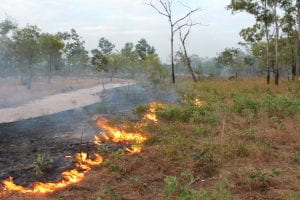
It has been a productive summer so far as collaborations over the past couple of years have yielded several papers. With David Bowman and colleagues, I helped frame an exciting study about the decline of a fire sensitive conifer in the highly flammable North Australia savannas. This paradox (a fire sensitive tree persisting in a landscape with lots of fire) can be explained by the high levels of pyrodiversity created by Aboriginal patch burning. Colonialism arrived to Arnhem Land relatively late but included population displacement (and the removal of Aboriginal fire management) and more recently superimposed institutionalized fire management that has driven this loss of ecological value.
With Grant Snitker and others, fire archaeologists of all stripes, we make the case that archaeologists and fire scientists should be working together to better understand the long, intertwined histories of people and fire.
With Tom Swetnam and Matt Liebmann, I reexamined a number of tree-ring and geoarchaeological fire studies across the Southwest US to look at the consequences of Indigenous population removal and other processes of colonialism on Southwest fire regimes.
Bowman, David M.J.S., Grant J. Williamson, Fay H. Johnston, Clarence J.W. Bowman, Brett P. Murphy, Christopher I. Roos, Clay Trauernicht, Joshua Rostron, and Lynda D. Prior
2022 Population Collapse of a Gondwanan Conifer Follows the Loss of Indigenous Fire Regimes in a Northern Australian Savanna. Scientific Reports 12:9081. [PDF] [LINK].
Roos, Christopher I., Thomas W. Swetnam, and Matthew J. Liebmann
2022 Rebound of Fire Regimes in Southwest US Forests and Woodlands, 1200-1900 CE. In Questioning Rebound: People and Environmental Change in Protohistoric and Early Historic Americas (ed. E. Jones and J. Fisher), pp. 54-65. University of Utah Press. [PDF].
Snitker, Grant, Christopher I. Roos, Alan P. Sullivan III, S. Yoshi Maezumi, Douglas W. Bird, Michael R. Coughlan, Kelly M. Derr, Linn Gassaway, Anna Klimaszewski-Patterson, Rachel A. Loehman
2022 A Collaborative Agenda for Archaeology and Fire Science. Nature Ecology & Evolution 6:835-839. [PDF] [LINK].
Utah State University Ecology Center Seminar series
I recently had the pleasure of visiting Utah State University, where I gave two talks as part of the Ecology Center Seminar series. You can catch both talks below as well as a short radio interview that I did for the local NPR station.
Check out the NPR interview here.
High-severity fires and shrubfield establishment (new paper)
Fire is an important part of maintaining some ecosystems but it can also be a catalyst for change. An illustration of this are the small but persistent shrub patches that dot pine forests across the Southwest US. These shrub patches were created by high-severity fires that killed the canopy, thus allowing resprouting species, such as Gambel oak to establish. But just how long these shrub patches can persist has not been clear.
Chris Guiterman and I used tree-rings and soil charcoal to identify the timing of high-severity fires that established three of the largest shrub patches in the Jemez Mountains of northern New Mexico. You can read more about it here.
Video of Southwest Fire Science Consortium webinar
The Southwest Fire Science Consortium webinar that I co-lead with Chris Toya and John Galvan from the Pueblo of Jemez Natural Resources Department is now available to stream on Youtube. Here I lay out the science and traditions behind centuries of sustainable Jemez (Hemish) fire management before Spanish colonialism. Chris and John put this in a cultural and contemporary context.
SW Fire Science Consortium webinar at noon MST on March 4, 2021
Come see me at the March 4 SW Fire Science Consortium webinar (noon MST). With colleagues from Jemez Pueblo, I will be talking about lessons for coexistence with wildfire from Native American fire management at an ancient wildland-urban interface.
March 4, 2021: Native American fire management at an ancient wildland–urban interface